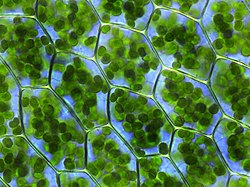Plastid
A plastid is a self-reproducing organelle of plants and algae. A plastome is the DNA genome of a plastid.[1]p341 They are like tiny machines inside cells: each makes or stores important chemicals used by the plant.


Examples of plastids are:
- Chloroplasts: photosynthesis; other plastids may have developed from chloroplasts. Etioplasts are chloroplasts which have not been exposed to light.
- Chromoplasts: pigment synthesis and storage.
- Leucoplasts: colourless, make terpenes such as resin. Sometimes they develop into more specialized types of plastid:
Plastids in algae
changePlastids in algae and hornworts may differ from plant plastids. In algae, the term "leucoplast" is used for all unpigmented plastids and their function differs from the leucoplasts of plants.
Glaucocystophytic algae contain muroplasts, which are similar to chloroplasts except that they have a cell wall, similar to that of prokaryotes. Rhodophytic algae contain rhodoplasts, which are red chloroplasts which allow the algae to photosynthesise to a depth of up to 268 metres.[2]
Genetics and evolution
changePlastids are one of the many different types of organelles in the cell. In endosymbiont theory, plastids originated as cyanobacteria. This was first suggested by Mereschkowsky in 1905.[3][4] Schimper in 1883 had said chloroplasts closely resembled cyanobacteria.[5]
Almost all chloroplasts are thought to derive directly or indirectly from a single endosymbiotic event.[6] Mitochondria also derive from symbiosis, but chloroplasts are found only in plants and protista. The chloroplast is surrounded by a double-layered composite membrane with an intermembrane space; further, it has reticulations, or many infoldings, filling the inner spaces. The chloroplast has its own DNA, which codes for redox proteins involved in electron transport in photosynthesis.[7]
References
change- ↑ King R.C. Stansfield W.D. & Mulligan P.K. 2006. A dictionary of genetics, 7th ed. Oxford.
- ↑ Wise, Robert R. 2006. The diversity of plastid form and function". Advances in Photosynthesis and Respiration. 23, 3–26. [1]
- ↑ Mereschkowsky C. 1905. "Über Natur und Ursprung der Chromatophoren im Pflanzenreiche". Biol Centralbl. 25: 593–604.
{{cite journal}}: CS1 maint: numeric names: authors list (link) - ↑ Khakhina L.N. 1992. Concepts of symbiogenesis: a historical and critical survey of the research of Russian botanists. Yale, New Haven CN.
- ↑ Schimper A.F.W. 1883. "Über die Entwicklung der Chlorophyllkörner und Farbkörper". Bot. Zeitung. 41: 105–14, 121–31, 137–46, 153–62.
{{cite journal}}: CS1 maint: numeric names: authors list (link) - ↑ Keeling, Patrick J. 2004 (2004). "Diversity and evolutionary history of plastids and their hosts". American Journal of Botany. 91 (10): 1481–1493. doi:10.3732/ajb.91.10.1481. PMID 21652304. S2CID 17522125.
{{cite journal}}: CS1 maint: numeric names: authors list (link) - ↑ Krause K. 2008 (2008). "From chloroplasts to "cryptic" plastids: evolution of plastid genomes in parasitic plants". Curr. Genet. 54 (3): 111–21. doi:10.1007/s00294-008-0208-8. PMID 18696071. S2CID 24879257.
{{cite journal}}: CS1 maint: numeric names: authors list (link)